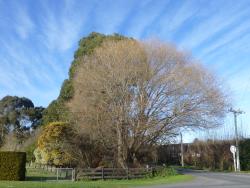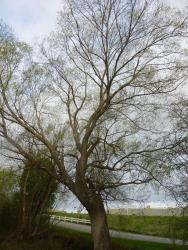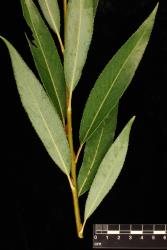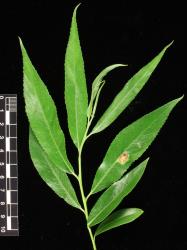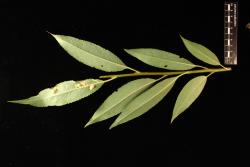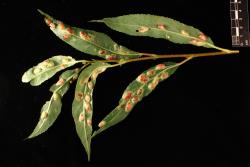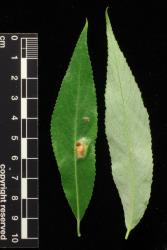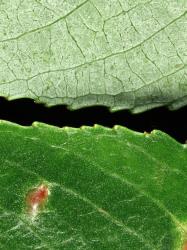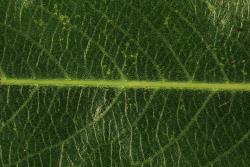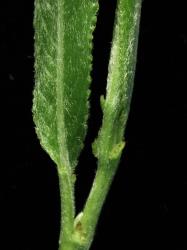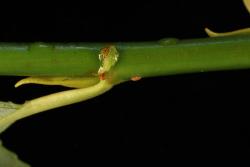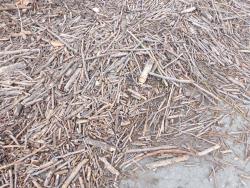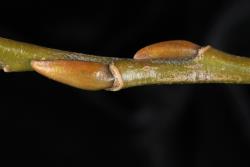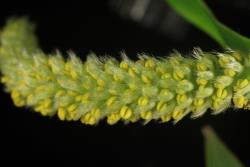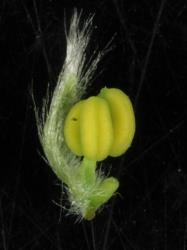- Taxon
- Weed
- Gallery
Trees 8–14 m high, with trunk up to 2.3 m diameter, or with multiple trunks, bark greyish brown and fissured. Current year's branchlets glabrous to densely covered in short-silky hairs, hairs not persisting. Year-old branchlets glabrous, 2.1–3.1 mm diameter. Flowering branch bud scales 4.0–9.5 mm long, 2.5–4.0 mm wide, 1.8–2.6 mm deep, ovoid, compressed and with 2 lateral angles, brown to brownish orange, hairs absent or present only at base and apex by time of catkin emergence, scale falling rapidly after branch emergence. Stipule 0.2–7 mm long, gland-like, subulate, or very narrowly ovate, not persisting. Petiole 6–30 mm long, glabrous to densely short-silky hairy, adaxial groove present, rarely absent, glands absent or present. Emerging leaves pale green to green, glabrous or with sparse to dense long-silky hairs. Proximal leaves usually toothed, sometimes entire. Leaf lamina 61–197 mm long, 17–48 mm wide, length to width ratio 3.3–6.6:1, narrowly elliptical to very narrowly ovate, not or weakly falcate; base cuneate; apex acute, very narrowly acute, or acuminate; leaf galls uncommon to abundant, red, rarely blackish; orange rust absent in late summer; margins densely serrulate; upper lamina surface smooth, occasionally with midvein raised, slightly glossy to medium-glossy, glabrous or with sparse long-silky hairs, stomata dense; lower lamina surface with midvein raised, side-veins and netted veins visible, glaucous, glabrous or sparsely to moderately densely long-silky hairy. Catkin emergence simultaneous with leaves or emerging after leaves. Flowering male branch 52–73 mm long, 3–4 leaves on flowering branch. Male catkin 30–63 mm long, 7–10 mm diameter; catkin rachis visible between flowers. Male flower bract 1.7–3.0 mm long, 0.6–1.6 mm wide, pale green or pale yellow-green, channelled and curved inwards on long axis; apex obtuse to rounded; long-silky hairs on both surfaces and margins or on outer surface near the base and margins only. Male nectaries 2, 0.3–0.7 mm long, 0.2–0.7 mm wide, yellow. Stamens 2, filaments free, hairs present at base of filament; anthers 0.9–1.2 mm long, yellow. Flowering female branch 30–62 mm long at flowering. Female catkin 6–8 mm diameter; catkin rachis visible between flowers. Female flower bract 1.1–4.0 mm long, 0.6–1.6 mm wide, pale green or pale yellow-green, channelled or flat at base, narrowly obovate; apex acute to obtuse; sparse long-silky hairs on inner surface and margins, deciduous. Female nectary 1, 0.4–0.6 mm long, 0.3–0.7 mm wide, yellow; ovary 1.8–2.8 mm long, glabrous, stipe 0–0.2 mm long at flowering. Style base 0.1–0.6 mm long (extending after flowering to 0.8 mm long), style arms 0.4–0.6 mm long, extending after flowering to 0.8 mm long, lobed halfway to base, stigmatic surfaces hyaline.
| Category | Number |
|---|---|
| Exotic: Fully Naturalised | 2 |
| Total | 2 |



